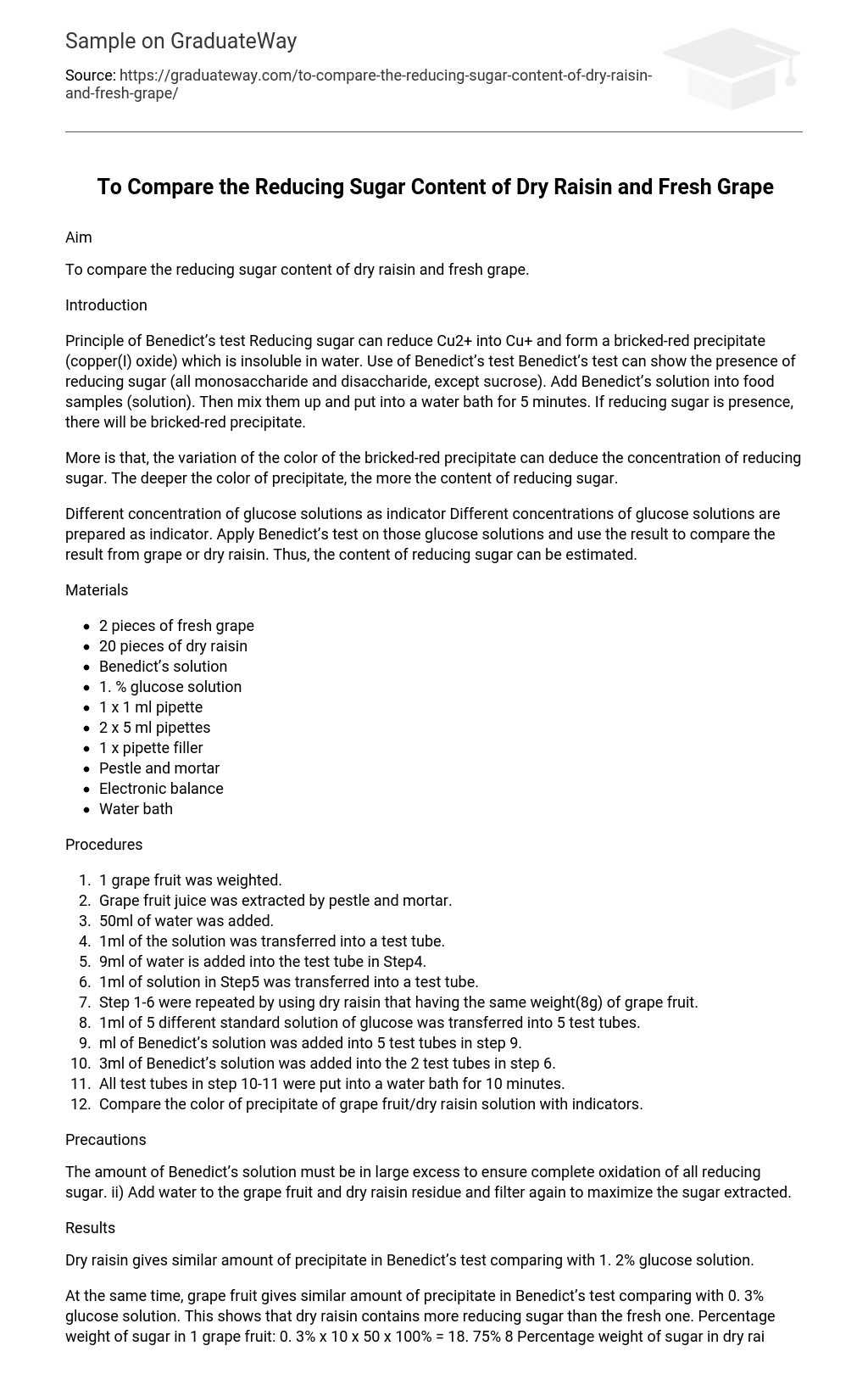Aim
To compare the reducing sugar content of dry raisin and fresh grape.
Introduction
Principle of Benedict’s test Reducing sugar can reduce Cu2+ into Cu+ and form a bricked-red precipitate (copper(I) oxide) which is insoluble in water. Use of Benedict’s test Benedict’s test can show the presence of reducing sugar (all monosaccharide and disaccharide, except sucrose). Add Benedict’s solution into food samples (solution). Then mix them up and put into a water bath for 5 minutes. If reducing sugar is presence, there will be bricked-red precipitate.
More is that, the variation of the color of the bricked-red precipitate can deduce the concentration of reducing sugar. The deeper the color of precipitate, the more the content of reducing sugar.
Different concentration of glucose solutions as indicator Different concentrations of glucose solutions are prepared as indicator. Apply Benedict’s test on those glucose solutions and use the result to compare the result from grape or dry raisin. Thus, the content of reducing sugar can be estimated.
Materials
- 2 pieces of fresh grape
- 20 pieces of dry raisin
- Benedict’s solution
- 1. % glucose solution
- 1 x 1 ml pipette
- 2 x 5 ml pipettes
- 1 x pipette filler
- Pestle and mortar
- Electronic balance
- Water bath
Procedures
- 1 grape fruit was weighted.
- Grape fruit juice was extracted by pestle and mortar.
- 50ml of water was added.
- 1ml of the solution was transferred into a test tube.
- 9ml of water is added into the test tube in Step4.
- 1ml of solution in Step5 was transferred into a test tube.
- Step 1-6 were repeated by using dry raisin that having the same weight(8g) of grape fruit.
- 1ml of 5 different standard solution of glucose was transferred into 5 test tubes.
- ml of Benedict’s solution was added into 5 test tubes in step 9.
- 3ml of Benedict’s solution was added into the 2 test tubes in step 6.
- All test tubes in step 10-11 were put into a water bath for 10 minutes.
- Compare the color of precipitate of grape fruit/dry raisin solution with indicators.
Precautions
The amount of Benedict’s solution must be in large excess to ensure complete oxidation of all reducing sugar. ii) Add water to the grape fruit and dry raisin residue and filter again to maximize the sugar extracted.
Results
Dry raisin gives similar amount of precipitate in Benedict’s test comparing with 1. 2% glucose solution.
At the same time, grape fruit gives similar amount of precipitate in Benedict’s test comparing with 0. 3% glucose solution. This shows that dry raisin contains more reducing sugar than the fresh one. Percentage weight of sugar in 1 grape fruit: 0. 3% x 10 x 50 x 100% = 18. 75% 8 Percentage weight of sugar in dry raisin having similar weight with 1 grape fruit: 1. 2% x 10 x 50 x 100% = 75. 38% 8
Conclusion
The amount of reducing sugar in dry raisin is more than the fresh grape fruit.
Discussion
Variations among the dry raisin: Particular brand of raisin may contain more or less reducing sugar than others brand. We may use 3 or 4 brands of raisin instead of using and take the average from the results.
Large gap between the standard solutions: The difference between each standard solutions is 0. 3%. In order to increase the accuracy of the experiment, we may reduce the difference from 0. 3% to 0. 1%.
Types of sugar in the samples: The sweet taste of the sample may not only be contributed by reducing sugar. We may carry out another test which can also test the non-reducing sugar.





